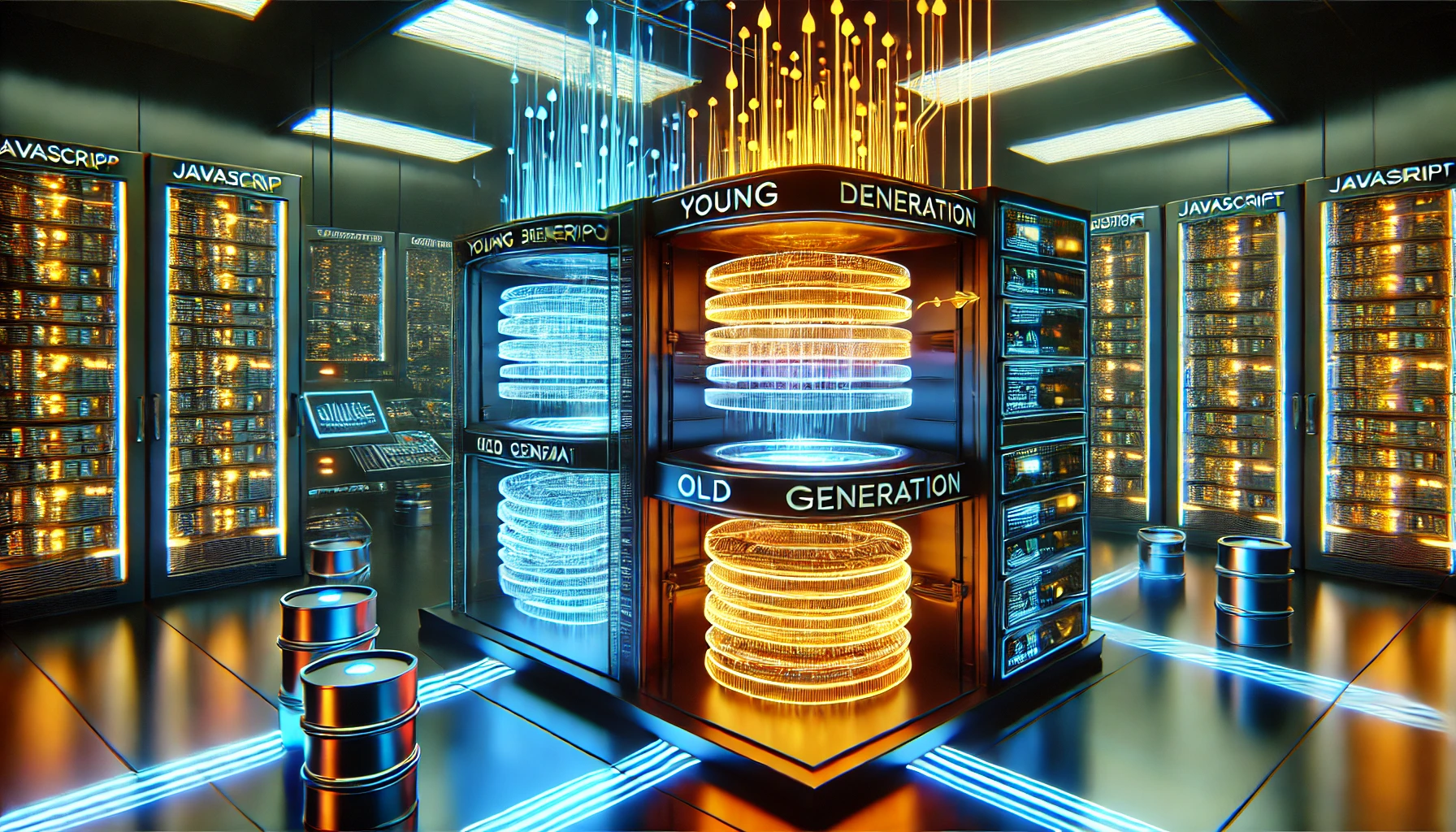Sajiron
Understanding JavaScript’s Generational Garbage Collection in V8

Efficient memory management is a critical aspect of modern programming, and JavaScript, despite being a garbage-collected language, has its own challenges in handling memory efficiently. The V8 engine (used in Chrome and Node.js) implements an optimized Generational Garbage Collection (GC) model to improve performance and responsiveness.
In this blog post, we’ll explore how JavaScript’s garbage collection works, the generational model in V8, and best practices for writing memory-efficient JavaScript code.
1. What is Garbage Collection?
Garbage collection (GC) is the process of automatically freeing up memory occupied by objects that are no longer reachable in the program. JavaScript primarily uses heap memory to allocate objects dynamically. The garbage collector automatically detects unused objects and removes them, preventing memory leaks.
The main memory allocation areas in JavaScript:
Stack: Stores primitive values and function calls.
Heap: Stores objects and dynamically allocated memory.
The garbage collector primarily operates on the heap.
2. Introducing Generational Garbage Collection
JavaScript engines like V8 (used in Chrome and Node.js) use a generational GC model to optimize memory management. This model divides memory into two main generations: the Young Generation (New Space) and the Old Generation (Old Space). The Young Generation stores newly allocated objects and uses frequent and fast garbage collection. Objects that survive multiple GC cycles get promoted to the Old Generation, which stores long-lived objects and uses less frequent but more intensive GC techniques such as the Mark-Sweep & Mark-Compact algorithms.
Most objects in JavaScript die quickly (e.g., function-scoped variables, temporary objects). Instead of scanning the entire heap every time, a generational approach allows quick collection of short-lived objects while postponing expensive collection of long-lived objects.
3. How V8’s Garbage Collection Works
Step 1: Minor GC (Scavenge) in Young Generation
When objects are created, they are stored in the Young Generation (New Space), which is divided into two semi-spaces: the Active (From space) where new objects are allocated, and the Inactive (To space) which serves as an empty space used during garbage collection. In Minor GC, the garbage collector scans the "From space", copies surviving objects to the "To space", discards non-surviving objects, and swaps the roles of "From" and "To" space. If an object survives multiple minor GCs, it is moved to the Old Generation.
Step 2: Major GC (Mark-Sweep & Mark-Compact) in Old Generation
Once objects are promoted to the Old Generation, a different GC algorithm is used. The Mark-Sweep process identifies and removes unreachable objects, while Mark-Compact reduces memory fragmentation by moving objects closer together. During Major GC, the garbage collector performs three key steps: marking reachable objects, sweeping unreachable objects, and compacting the memory to eliminate fragmentation. Since this process is expensive, V8 runs Major GC less frequently.
4. Performance Optimizations in V8’s GC
Modern JavaScript engines optimize garbage collection to minimize performance impact. V8 introduces several enhancements such as Incremental GC, which splits garbage collection into smaller tasks to prevent performance hiccups, Concurrent GC, which runs GC in parallel with JavaScript execution for better responsiveness, and Lazy Sweeping, which delays memory cleanup to reduce CPU load.
5. Common Memory Issues & Garbage Collection
Even with automatic GC, JavaScript applications can suffer from memory leaks. Here are some common pitfalls:
Memory Leaks Due to Global Variables
Objects stored in global scope are never garbage collected.
Example:
function leakMemory() {
globalVar = { name: "Memory Leak" }; // Stays in memory forever
}✅ Fix: Always declare variables with let or const:
function noLeak() {
let localVar = { name: "No Leak" }; // Memory is released after function call
}Circular References
Two objects referencing each other prevent GC from collecting them.
Example:
function createCircularReference() {
let a = {};
let b = {};
a.ref = b;
b.ref = a; // Circular reference
}✅ Fix: Use WeakMap instead of a normal object reference:
let weakMap = new WeakMap();
let obj1 = {};
weakMap.set(obj1, "some data"); // Can be garbage collected when obj1 is unreachableDetached DOM Elements
Removing an element from the DOM doesn’t automatically remove references.
Example:
let element = document.getElementById("myElement");
document.body.removeChild(element); // Still referenced in `element`✅ Fix:
element = null; // Allow garbage collection6. Best Practices for Memory Optimization
To write memory-efficient JavaScript, follow these best practices:
✅ Avoid excessive global variables.
✅ Use let and const instead of undeclared global variables.
✅ Nullify unused objects (obj = null;).
✅ Use WeakMap and WeakSet for short-lived data.
✅ Manually remove event listeners (element.removeEventListener).
✅ Break circular references when no longer needed.
7. Conclusion
JavaScript’s V8 engine uses a generational garbage collection model to optimize memory management. By splitting memory into young and old generations, V8 improves efficiency and performance. Frequent Minor GC handles short-lived objects in the young generation, while objects that survive multiple GC cycles get promoted to the old generation. Major GC uses Mark-Sweep & Mark-Compact to clear memory, and optimizations like Incremental & Concurrent GC improve performance.
By following best practices in JavaScript memory management, you can write high-performance applications that efficiently utilize resources.
Want to Learn More?
Check out V8 Garbage Collection Docs.
Read about JavaScript memory leaks and performance tuning.
Recommended

# The Difference Between `null`, `undefined`, and `NaN` in JavaScript
Understand the key differences between null, undefined, and NaN in JavaScript with clear examples, use cases, and best practices for each.

Debouncing vs Throttling in JavaScript: When to Use Each
Learn the difference between debouncing and throttling in JavaScript. Improve performance and user experience with simple examples and use cases.

Mathematical Foundations for Machine Learning in JavaScript
Explore essential math for machine learning—vectors, matrices, calculus, and probability—explained with beginner-friendly JavaScript code.

Understanding Data Preprocessing in JavaScript
Learn data preprocessing in JavaScript for Machine Learning. Clean, transform, and structure data with practical examples to boost ML model accuracy!